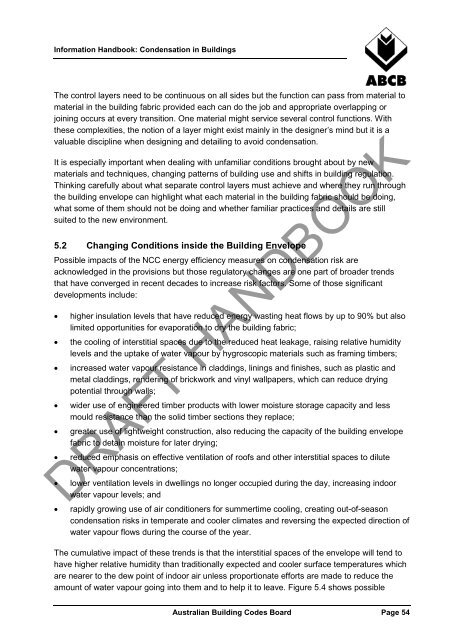Condensation in Buildings - Australian Building Codes Board
Condensation in Buildings - Australian Building Codes Board
Condensation in Buildings - Australian Building Codes Board
You also want an ePaper? Increase the reach of your titles
YUMPU automatically turns print PDFs into web optimized ePapers that Google loves.
Information Handbook: <strong>Condensation</strong> <strong>in</strong> Build<strong>in</strong>gs<br />
The control layers need to be cont<strong>in</strong>uous on all sides but the function can pass from material to<br />
material <strong>in</strong> the build<strong>in</strong>g fabric provided each can do the job and appropriate overlapp<strong>in</strong>g or<br />
jo<strong>in</strong><strong>in</strong>g occurs at every transition. One material might service several control functions. With<br />
these complexities, the notion of a layer might exist ma<strong>in</strong>ly <strong>in</strong> the designer’s m<strong>in</strong>d but it is a<br />
valuable discipl<strong>in</strong>e when design<strong>in</strong>g and detail<strong>in</strong>g to avoid condensation.<br />
It is especially important when deal<strong>in</strong>g with unfamiliar conditions brought about by new<br />
materials and techniques, chang<strong>in</strong>g patterns of build<strong>in</strong>g use and shifts <strong>in</strong> build<strong>in</strong>g regulation.<br />
Th<strong>in</strong>k<strong>in</strong>g carefully about what separate control layers must achieve and where they run through<br />
the build<strong>in</strong>g envelope can highlight what each material <strong>in</strong> the build<strong>in</strong>g fabric should be do<strong>in</strong>g,<br />
what some of them should not be do<strong>in</strong>g and whether familiar practices and details are still<br />
suited to the new environment.<br />
5.2 Chang<strong>in</strong>g Conditions <strong>in</strong>side the Build<strong>in</strong>g Envelope<br />
Possible impacts of the NCC energy efficiency measures on condensation risk are<br />
acknowledged <strong>in</strong> the provisions but those regulatory changes are one part of broader trends<br />
that have converged <strong>in</strong> recent decades to <strong>in</strong>crease risk factors. Some of those significant<br />
developments <strong>in</strong>clude:<br />
• higher <strong>in</strong>sulation levels that have reduced energy wast<strong>in</strong>g heat flows by up to 90% but also<br />
limited opportunities for evaporation to dry the build<strong>in</strong>g fabric;<br />
• the cool<strong>in</strong>g of <strong>in</strong>terstitial spaces due to the reduced heat leakage, rais<strong>in</strong>g relative humidity<br />
levels and the uptake of water vapour by hygroscopic materials such as fram<strong>in</strong>g timbers;<br />
• <strong>in</strong>creased water vapour resistance <strong>in</strong> cladd<strong>in</strong>gs, l<strong>in</strong><strong>in</strong>gs and f<strong>in</strong>ishes, such as plastic and<br />
metal cladd<strong>in</strong>gs, render<strong>in</strong>g of brickwork and v<strong>in</strong>yl wallpapers, which can reduce dry<strong>in</strong>g<br />
potential through walls;<br />
• wider use of eng<strong>in</strong>eered timber products with lower moisture storage capacity and less<br />
mould resistance than the solid timber sections they replace;<br />
• greater use of lightweight construction, also reduc<strong>in</strong>g the capacity of the build<strong>in</strong>g envelope<br />
fabric to deta<strong>in</strong> moisture for later dry<strong>in</strong>g;<br />
• reduced emphasis on effective ventilation of roofs and other <strong>in</strong>terstitial spaces to dilute<br />
water vapour concentrations;<br />
DRAFT HANDBOOK<br />
• lower ventilation levels <strong>in</strong> dwell<strong>in</strong>gs no longer occupied dur<strong>in</strong>g the day, <strong>in</strong>creas<strong>in</strong>g <strong>in</strong>door<br />
water vapour levels; and<br />
• rapidly grow<strong>in</strong>g use of air conditioners for summertime cool<strong>in</strong>g, creat<strong>in</strong>g out-of-season<br />
condensation risks <strong>in</strong> temperate and cooler climates and revers<strong>in</strong>g the expected direction of<br />
water vapour flows dur<strong>in</strong>g the course of the year.<br />
The cumulative impact of these trends is that the <strong>in</strong>terstitial spaces of the envelope will tend to<br />
have higher relative humidity than traditionally expected and cooler surface temperatures which<br />
are nearer to the dew po<strong>in</strong>t of <strong>in</strong>door air unless proportionate efforts are made to reduce the<br />
amount of water vapour go<strong>in</strong>g <strong>in</strong>to them and to help it to leave. Figure 5.4 shows possible<br />
<strong>Australian</strong> Build<strong>in</strong>g <strong>Codes</strong> <strong>Board</strong> Page 54
















